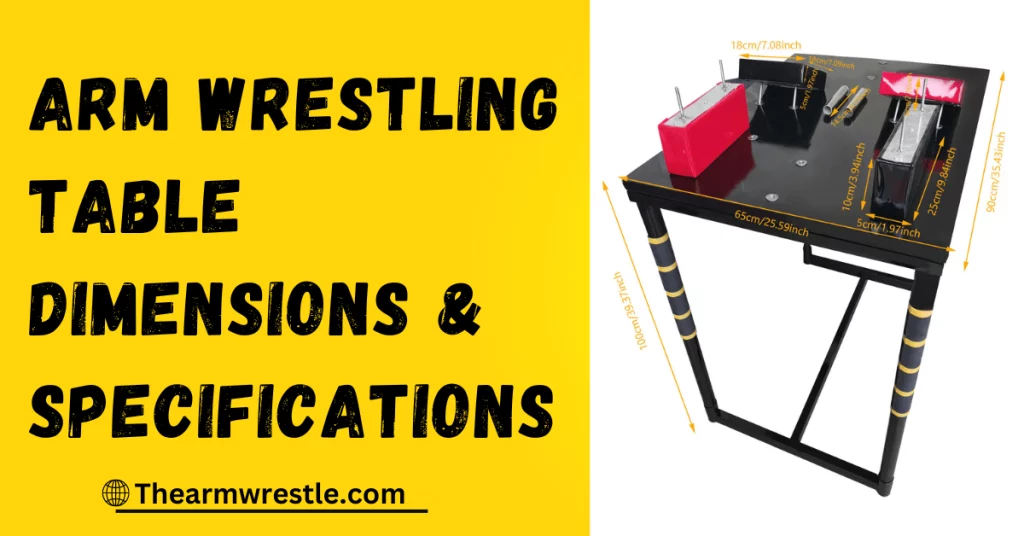Discover essential techniques to improve your arm wrestling skills with our comprehensive guide. Learn about Rising, Cupping, Wrist Cupping, Pronation, Belt Grip, and Strength Training to dominate your arm wrestling matches. Perfect for beginners and seasoned competitors alike
Here’s a list of key techniques how to get better at arm wrestling.
- Rising
- Cupping
- Wrist Cupping
- Pronation
- Belt Grip
- Strength Training
Rising
The Rising technique in arm wrestling is a strategic move that focuses on lifting your opponent’s hand upwards to gain leverage. This technique is not just about physical strength; it’s about understanding the mechanics of leverage and using it to your advantage.
How Rising Works
Rising works by targeting the weakest point in your opponent’s grip – typically the fingers or the wrist. By lifting their hand upwards, you disrupt their stable position, making it harder for them to apply force effectively. This move shifts the battle from sheer force to a more strategic manipulation of leverage.
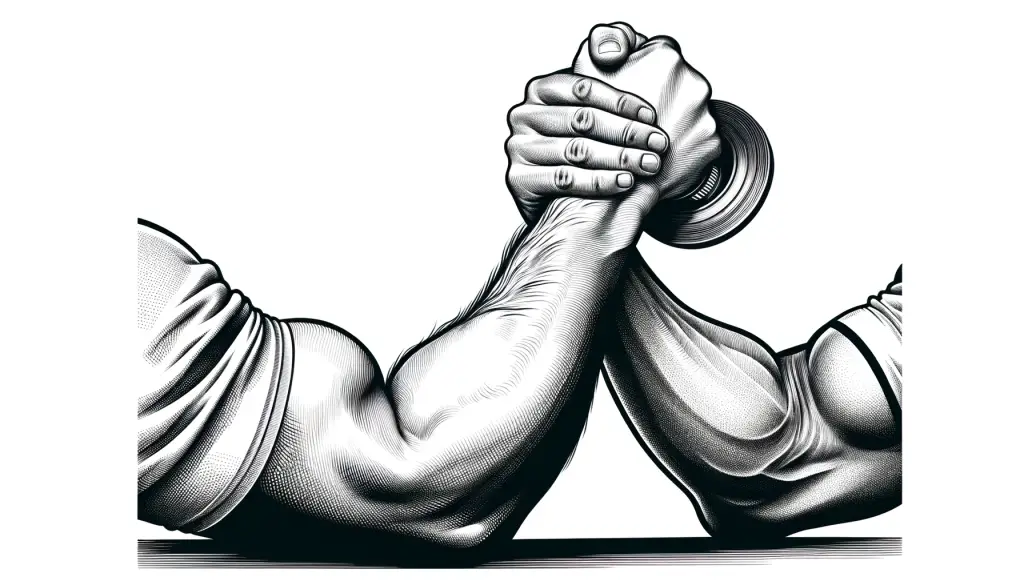
Mechanics of Rising
The key to rising is in the wrist and fingers. The action involves a combination of wrist flexion and finger extension. By flexing your wrist upwards while extending your fingers, you create an upward force on your opponent’s grip. This movement requires strength in the forearm and flexibility in the wrist.
Implementing Rising in a Match
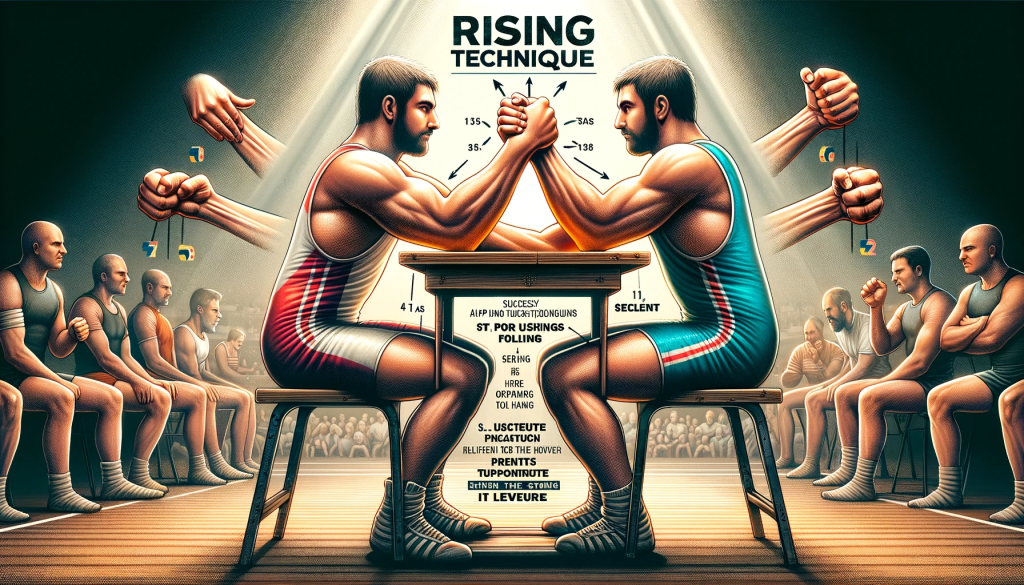
To effectively implement rising in a match:
- Start with a Strong Grip: Secure a firm grip on your opponent’s hand. Your grip should be tight enough to control their movements but flexible enough to maneuver.
- Apply Upward Pressure: Once you have a grip, start applying upward pressure by flexing your wrist and extending your fingers. The goal is to lift their hand away from their body.
- Maintain Control: As you lift their hand, maintain control and watch for their counter-movements. Be ready to adjust your technique accordingly.
Training for Rising
To train for rising, focus on exercises that strengthen your wrists and forearms. Wrist curls, reverse wrist curls, and finger extensions are great exercises. Additionally, practicing the rising movement with a partner or using an arm wrestling table can help develop the specific muscles and techniques needed.
Cupping: Securing a Strong Grip
Cupping is a fundamental technique in arm wrestling that involves curling your hand towards your wrist. This move is essential for establishing and maintaining a strong, controlling grip on your opponent’s hand. Mastering cupping can significantly enhance your arm wrestling prowess by allowing you to dictate the flow of the match.
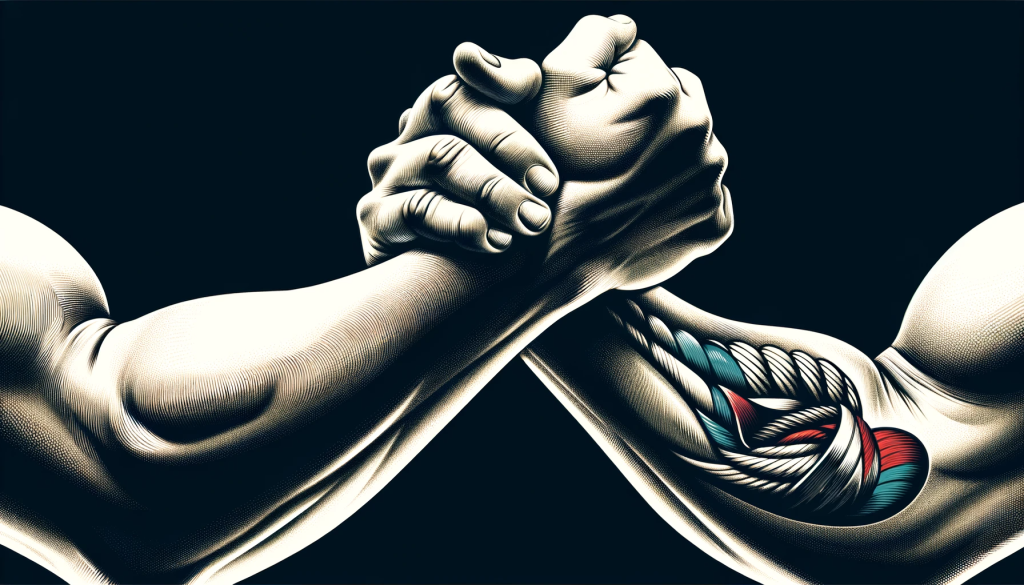
Understanding Cupping
Cupping centers around the concept of reducing your opponent’s leverage while maximizing your own. By curling your fingers and thumb towards your wrist, you effectively ‘cup’ your hand, creating a concave shape. This action tightens your grip and limits your opponent’s ability to maneuver or escape.
Implementing Cupping in a Match
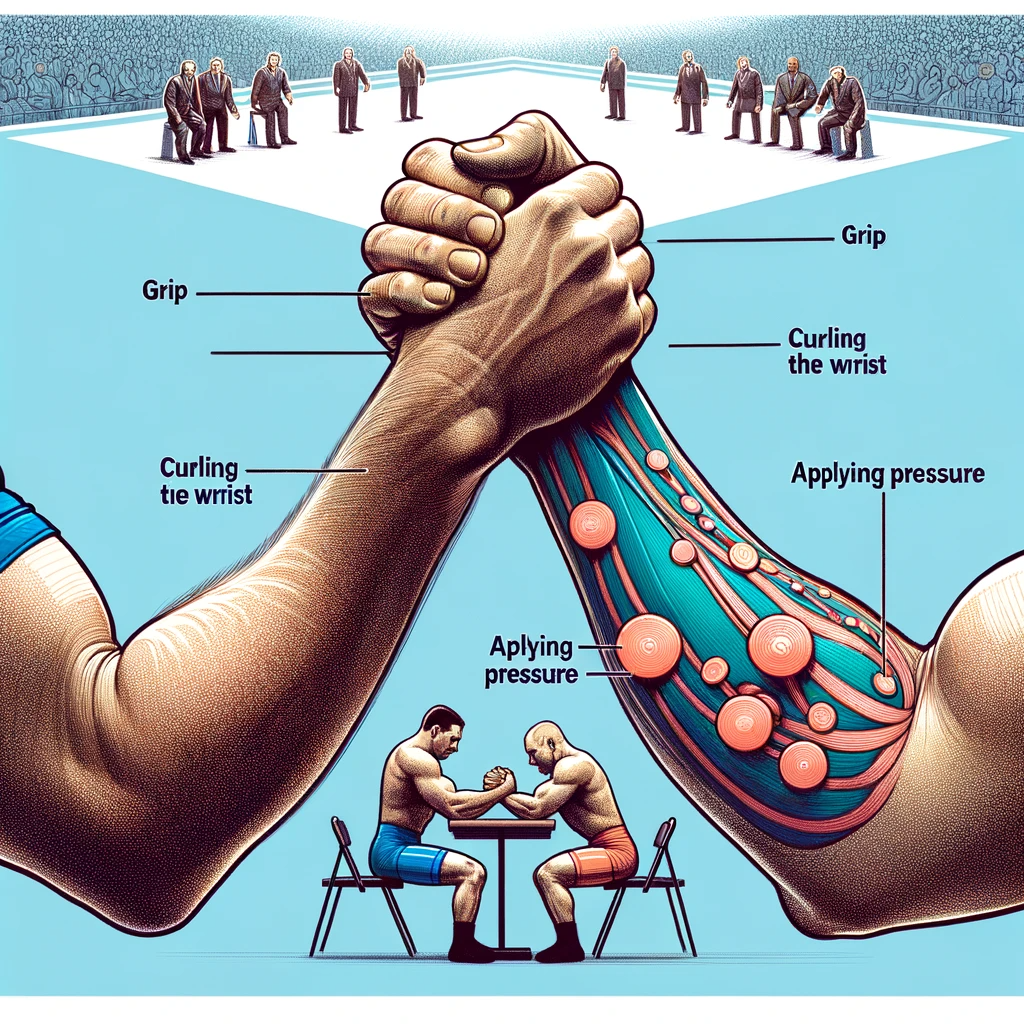
To successfully implement cupping:
- Start with a Solid Base: Ensure your arm and wrist are in a stable position. Your elbow should be firmly planted on the pad, providing a strong base for your movements.
- Engage Your Fingers and Thumb: Begin by curling your fingers tightly around your opponent’s hand. Your thumb plays a crucial role here, adding additional pressure.
- Curl Your Wrist: As your fingers grip, simultaneously curl your wrist towards your forearm. This combined action intensifies the cupping effect.
- Maintain Pressure: Once you have achieved the cupping position, maintain constant pressure. The goal is to keep your opponent’s hand in a compromised position.
Training for Cupping
To train for this technique, focus on exercises that strengthen your forearm flexors and enhance your grip strength. Activities such as wrist curls, finger curls, and grip strength trainers are beneficial. Additionally, practicing the cupping motion during sparring sessions can help in developing muscle memory and technique refinement.
Wrist Cupping: A Twist on Traditional Cupping
Wrist cupping is an advanced arm wrestling technique that builds upon the basic cupping move by adding a twist to the wrist. This nuanced approach not only enhances grip strength but also introduces an element of control that can be pivotal in a match. Understanding and mastering wrist cupping can give arm wrestlers an edge, especially in challenging bouts.
How Wrist Cupping Works
The technique starts with the basic cupping motion – curling your hand towards your wrist. Once this grip is established, you then add a twisting motion. This rotation typically involves turning your wrist inwards, towards your body. This movement not only strengthens your grip but also disrupts your opponent’s alignment and leverage.
Implementing Wrist Cupping
To effectively use wrist cupping in a match:
- Secure a Strong Base: As with any arm wrestling technique, start with a stable base. Your elbow should be anchored firmly on the pad, and your body positioned for maximum efficiency.
- Initiate Basic Cupping: Begin by curling your fingers and thumb around your opponent’s hand as in basic cupping.
- Add the Twist: Once your grip is secure, add the twist to your wrist. Rotate your wrist inwards, ensuring that you maintain pressure with your fingers and thumb.
- Control and Adjust: Use the combined cupping and twisting motion to control your opponent’s hand. Be prepared to adjust the intensity and angle of your twist based on their reactions and movements.
Training for Wrist Cupping
Developing proficiency in wrist cupping requires specific training focused on wrist flexibility and strength. Exercises like wrist curls with a twist, pronation and supination movements with weights, and grip strengthening exercises are particularly effective. Practice the combined cupping and twisting motion regularly to build muscle memory.
Advantage of Wrist Cupping
Wrist cupping offers a strategic advantage by providing a more secure grip and disrupting the opponent’s strategy. It can be particularly effective against opponents who rely heavily on their wrist strength or those who use techniques like top-rolling. Mastering wrist cupping can be a game-changer, especially in high-stakes matches where every little advantage counts.
Pronation: The Art of Twisting
Pronation in arm wrestling is a critical technique where you rotate your arm to make your palm face downwards. This movement is particularly effective for countering your opponent’s grip and can play a pivotal role in gaining the upper hand in a match. Mastering pronation can greatly enhance your arm wrestling abilities, providing a strategic advantage over opponents.
Understanding Pronation
Pronation involves rotating the forearm so that the palm turns to face down. This move is crucial in arm wrestling as it can weaken your opponent’s grip and reduce their leverage. By pronating your arm, you apply a twisting force that can disrupt your opponent’s position and strategy, making it difficult for them to maintain a strong hold.
Implementing Pronation in a Match
To successfully use pronation in a match:
- Start with a Firm Grip: Secure a strong grip on your opponent’s hand. A good grip is essential for effective pronation.
- Rotate Your Forearm: Initiate the pronation by rotating your forearm so that your palm starts to face downward. This action should be smooth yet forceful.
- Apply Pressure Downwards: As you pronate your arm, apply downward pressure to further weaken your opponent’s grip.
- Adjust Based on Response: Be attentive to your opponent’s reactions. Adjust the intensity and angle of your pronation based on their movements and counter-techniques.
Training for Pronation
Pronation in arm wrestling is a critical technique where you rotate your arm to make your palm face downwards. This movement is particularly effective for countering your opponent’s grip and can play a pivotal role in gaining the upper hand in a match. Mastering pronation can greatly enhance your arm wrestling abilities, providing a strategic advantage over opponents.
Advantage of Pronation
Pronation offers a strategic edge in arm wrestling by allowing you to counter various grip techniques and styles. It’s especially useful against opponents who rely on techniques like the top roll or hook. Effective pronation can shift the dynamics of a match, giving you the leverage to overpower your opponent.
Belt Grip
The Belt Grip is a lesser-known but highly effective technique in arm wrestling that involves utilizing your belt or waistband to gain additional stability and leverage during a match. This technique is particularly useful in situations where maintaining endurance and a steady position is crucial. Understanding and correctly implementing the Belt Grip can provide a significant advantage in arm wrestling competitions.
Understanding the Belt Grip
The Belt Grip technique is based on the principle of using your own body and clothing as leverage points. By gripping your belt or waistband with your non-wrestling hand, you create a point of stability that helps you anchor your body more effectively. This technique allows for better control over your movements and can help resist the force exerted by your opponent.
How the Belt Grip Works
In arm wrestling, balance and stability are as important as strength. The Belt Grip aids in maintaining a balanced posture by providing an additional anchor point. By holding onto your belt or waistband, you can prevent your body from being easily moved or twisted by your opponent’s actions, thereby maintaining a more advantageous position.
Implementing the Belt Grip in Matches
To effectively use the Belt Grip:
- Choose the Right Position: Situate yourself comfortably at the arm wrestling table with your feet firmly planted on the ground.
- Secure Your Grip: With your non-wrestling hand, firmly grip your belt or waistband. Ensure that the grip is strong and allows for a good range of motion.
- Maintain Posture: Use the grip to stabilize your upper body. This should help in maintaining a consistent posture throughout the match.
- Combine with Other Techniques: The Belt Grip should be used in conjunction with other arm wrestling techniques like cupping or pronation for maximum effectiveness.
Training for the Belt Grip
While the Belt Grip doesn’t require specific physical training, it does require practice to master. Incorporating this technique into your practice sessions will help you get accustomed to the feel and benefits it offers. Focus on maintaining the grip throughout various movements and techniques to understand how it affects your overall performance.
The Advantage of the Belt Grip
The main advantage of the Belt Grip is the added stability and leverage it provides. This can be especially beneficial in lengthy matches where endurance plays a crucial role. It also offers a psychological edge, as maintaining a steady and controlled posture can be intimidating to opponents.
Strength
In the world of arm wrestling, strength training is more than just a routine; it’s a crucial component for achieving success. While techniques and strategies are vital, the role of physical strength, particularly in the forearms, biceps, and shoulders, cannot be overstated. A well-rounded strength training program can significantly enhance your arm wrestling capabilities.
The Importance of Strength in Arm Wrestling
Arm wrestling demands a unique combination of strength, endurance, and power. It’s a sport that tests the limits of your arm’s muscular capabilities. Strengthening the muscles in your forearm, biceps, and shoulders not only improves your ability to exert force but also enhances your resistance against your opponent’s moves.
Target Areas for Strength Training
- Forearms: The muscles in your forearms are crucial for grip strength, wrist control, and executing techniques like cupping and pronation. Exercises like wrist curls, reverse wrist curls, and grip strengtheners are effective for building forearm strength.
- Biceps: Your biceps play a significant role in arm wrestling, providing the power needed for pulling movements. Incorporate exercises like bicep curls, hammer curls, and chin-ups to strengthen this muscle group.
- Shoulders: Strong shoulders contribute to overall arm stability and endurance. Shoulder exercises such as overhead presses, lateral raises, and front raises are essential for building shoulder strength.
Designing a Strength Training Program
- Consistency: Regular training is key. Aim for a balanced workout routine that targets all the necessary muscle groups, with a focus on gradual progression.
- Variety: Incorporate a range of exercises to target different muscle fibers and avoid plateaus. Include both compound movements for overall strength and isolation exercises for specific muscle groups.
- Intensity and Volume: Adjust the intensity and volume of your workouts depending on your experience and goals. Be mindful of the balance between training hard and allowing adequate recovery time.
- Sport-Specific Exercises: Include exercises that mimic arm wrestling movements. This specificity helps in translating the strength gains directly into your arm wrestling performance.
Incorporating Recovery
Recovery is as crucial as the workout itself. Ensure you have adequate rest days and consider incorporating recovery techniques like stretching, massage, or foam rolling. Proper nutrition and hydration are also vital for muscle repair and growth.
Conclusion
Improving at arm wrestling requires a mix of technique, strategy, and physical strength. By mastering techniques like Rising, Cupping, Wrist Cupping, Pronation, and the Belt Grip, and by enhancing your overall strength, you can significantly improve your performance in this challenging sport. Remember, consistent practice, dedication, and learning from each match are key to becoming a formidable arm wrestler.



